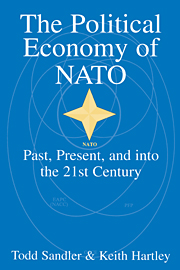Book contents
- Frontmatter
- Contents
- List of tables and figures
- Preface
- 1 NATO at the crossroads: An introduction
- 2 NATO burden sharing and related issues
- 3 On NATO expansion
- 4 NATO and peacekeeping
- 5 NATO and the defense industrial base: EU and USA
- 6 NATO challenges on the horizon
- 7 NATO and Europe
- 8 NATO design
- 9 Conclusions and future scenarios
- References
- Author index
- Subject index
6 - NATO challenges on the horizon
Published online by Cambridge University Press: 05 June 2012
- Frontmatter
- Contents
- List of tables and figures
- Preface
- 1 NATO at the crossroads: An introduction
- 2 NATO burden sharing and related issues
- 3 On NATO expansion
- 4 NATO and peacekeeping
- 5 NATO and the defense industrial base: EU and USA
- 6 NATO challenges on the horizon
- 7 NATO and Europe
- 8 NATO design
- 9 Conclusions and future scenarios
- References
- Author index
- Subject index
Summary
In the earlier chapters, NATO has been characterized as facing a host of challenges: identifying its strategic mission; deciding its membership size and composition; procuring the next generation of weapons; and adjusting its defense industrial base. There are myriad other challenges that will confront NATO in the decades ahead. If NATO is to remain relevant, then it must possess the capacity to redesign its forces, doctrines, missions, and institutional structures (see Chapter 8) so as to respond to the most worrisome of the potential threats. Because these challenges differ greatly from one another and involve diverse regions of the world, NATO cannot be expected to respond to all of them. Other defense and nondefense arrangements will be required to manage crises that surpass NATO's concerns or capabilities.
Security challenges can be addressed by formal (e.g., treaties, supranational structures) or informal (e.g., discussions) arrangements. Both formal and informal responses can involve a nonmilitary response (e.g., diplomacy, bargaining, economic sanctions) or a military response. The latter can include a variety of actions ranging from a threatened military sanction to an invasion, if all else fails. NATO must possess the means to address security concerns with an appropriately measured response. If the threat is minor and easily addressed, then NATO must show the requisite restraint to keep the crisis from escalating. When the threat affects interests beyond those of the NATO allies, a larger world body would best manage the exigency.
- Type
- Chapter
- Information
- The Political Economy of NATOPast, Present and into the 21st Century, pp. 165 - 200Publisher: Cambridge University PressPrint publication year: 1999



